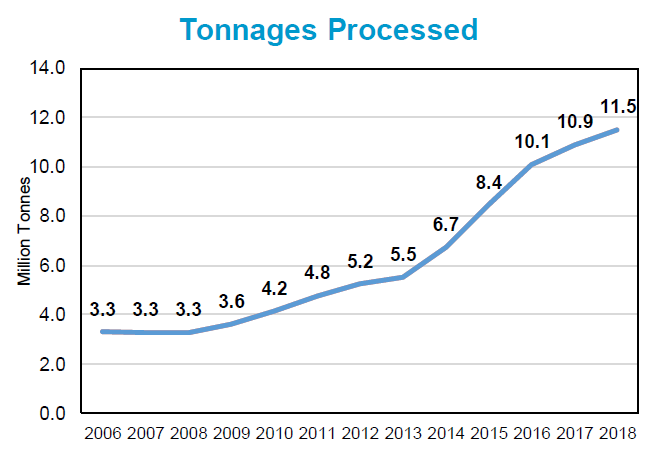Residual Waste EFW
Residual Waste can be used as a feedstock for Energy from Waste (EfW) and Residual Waste is considered as partially renewable or a low carbon energy source as a result of the energy produced from the fraction of Residual Waste derived from Biomass that is considered renewable[1].
Residual Waste and Energy from Waste
Energy from Waste is the now the main method for dealing with this type of waste, with Landfill of Residual Waste being the least preferred method, as outlined in the Waste Hierarchy[1].
In 2018, the amount of residual waste that was sent to EfW processes in the UK increased by 5.6%, amounting to a total of 11.5 million tonnes being sent to 42 operational EfW facilities across the UK[2]. This represents 41.8% of the total residual waste produced in the UK in 2018 (increasing from 39.5% in 2017)[2]. The total power generated from EfW facilities in 2018 was 6,153 GWh, this supplied 1.9% of the total UK power generation, and gives a average of 536 kWh of power generated per tonne of residual waste treated at UK EfW facilities[2].
The graph below displays how the tonnage of residual waste processes by UK EfW facilities has changed over recent years.

The table below shows the power and heat generation from residual waste EfW facilities in the UK between 2014-2018 (Derived from Tolvik, 2019[2]).
| Year | Net Power Export (GWhe) | Net Heat Export (GWhth) |
|---|---|---|
| 2014 | 3368 | NA |
| 2015 | 4636 | 554 |
| 2016 | 5241 | 730 |
| 2017 | 6187 | 865 |
| 2018 | 6153 | 1112 |
Historically, the UK has been very dependent on Landfill or Incineration without energy recovery for Disposal of Residual Waste. The landfill diversion targets set in the mid 1990s promoted EfW developments. The diversion of residual waste away from Landfill and into EfW processes reduces emissions of methane and pollution originating from Landfill sites and increases production of renewable energy[1].
England produced 12.5 million tonnes of Residual Waste from Households in 2016[3], and it is estimated that there will be an increase in EfW capacity for Residual Waste by 2 million tonnes/year by 2022 [4].
With the increasing social, economic and political drive to Prevent, Reuse and Recycle more waste, in line with the Waste Hierarchy and the Circular Economy the amount of Residual Waste is expected to decrease over time in the medium-long term[1]. The exact magnitude of this reduction and the Residual Waste continuing to need to be delivered to EfW has been debated at length by different commentators over the last few years.
Currently in the UK there are 42 operational EfW facilities utilising residual waste as a feedstock, 5 that are in the late stages of commissioning and 15 sites that are currently under construction[2]. The locations of these sites are shown in the map below.

References
- ↑ 1.0 1.1 1.2 1.3 Defra, 2014. Energy from Waste: A guide to the debate February 2014 (revised edition). London.
- ↑ 2.0 2.1 2.2 2.3 2.4 2.5 2.6 Tolvik Consulting, 2019. UK Energy from Waste Statistics – 2018. Gloucestershire.[online]
- ↑ Defra, 2018. Digest of Waste and Resources Statistics - 2018 Edition. London.
- ↑ Tolvik Consulting, 2017. UK Residual Waste: 2030 Market Review. Environmental Services Association.
